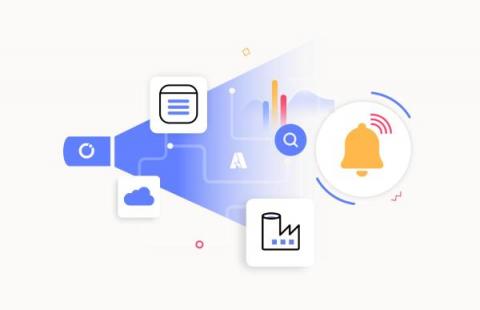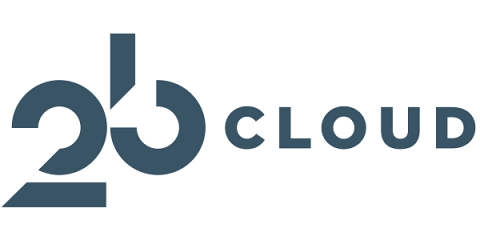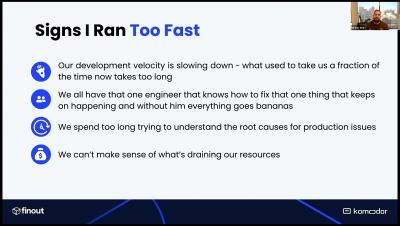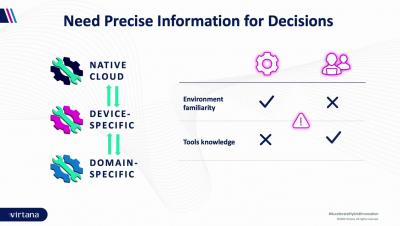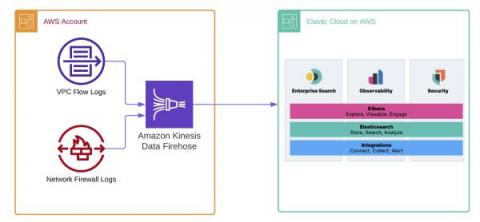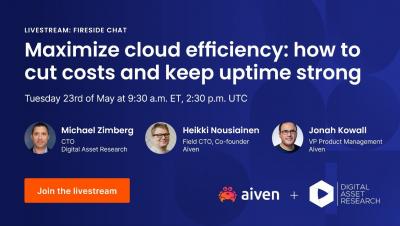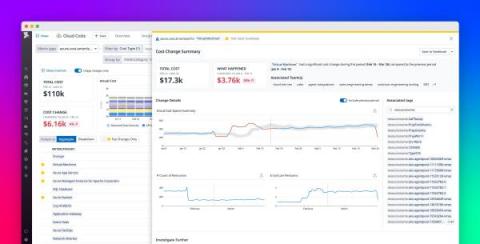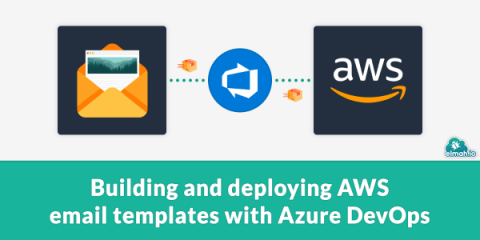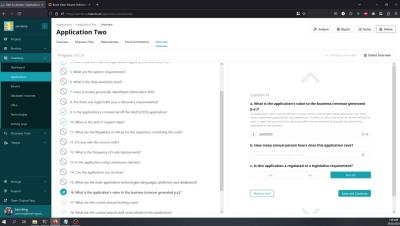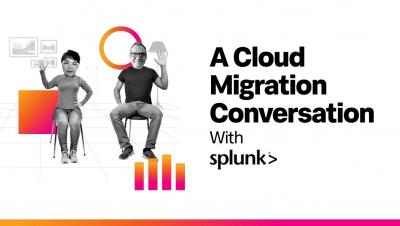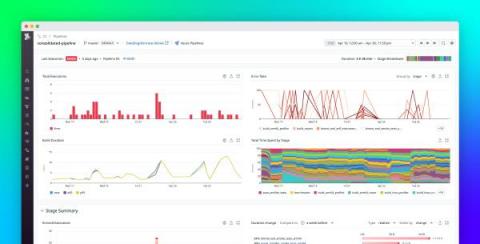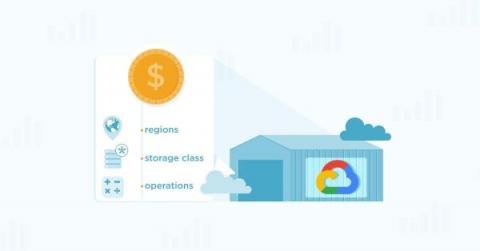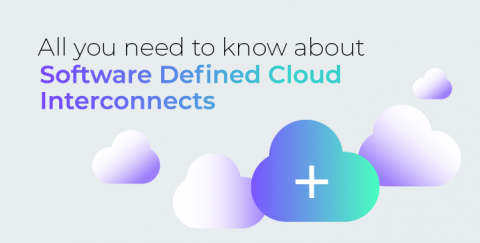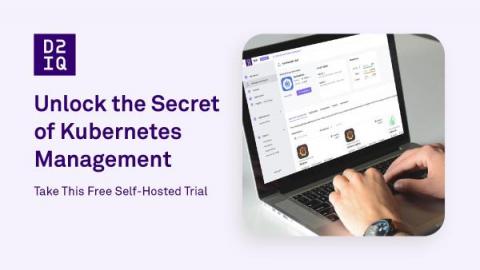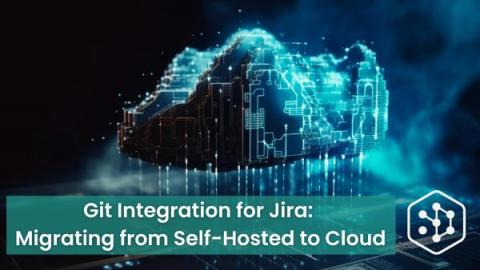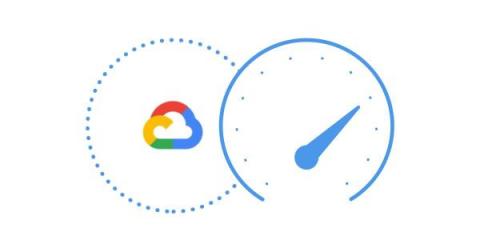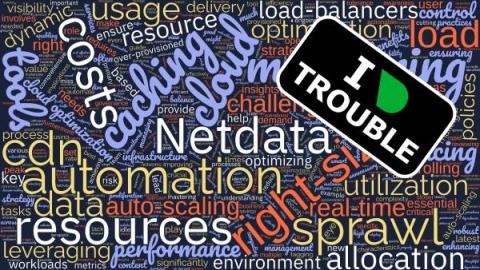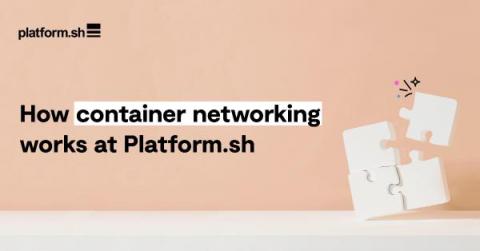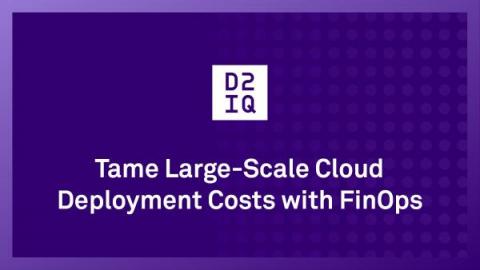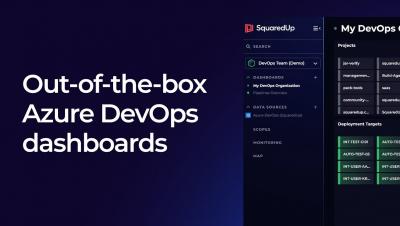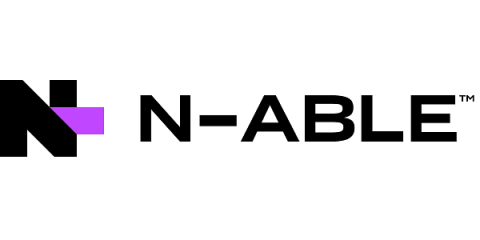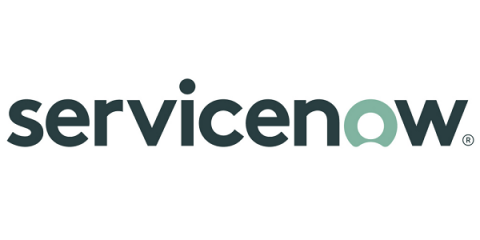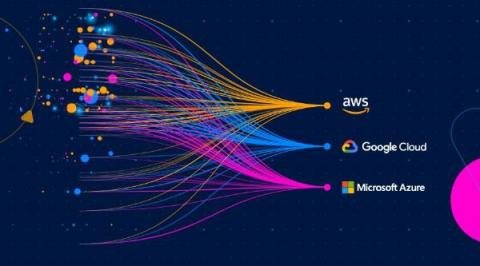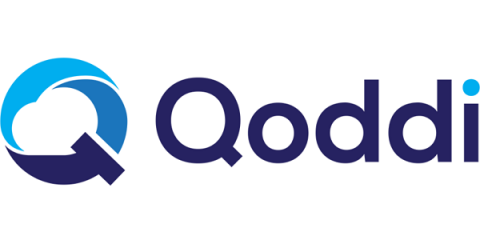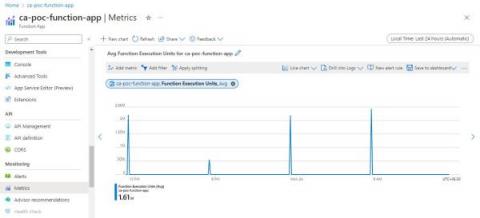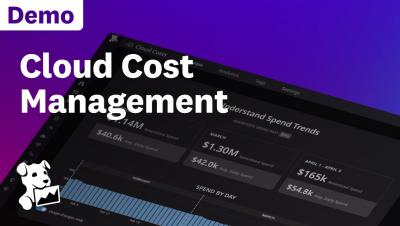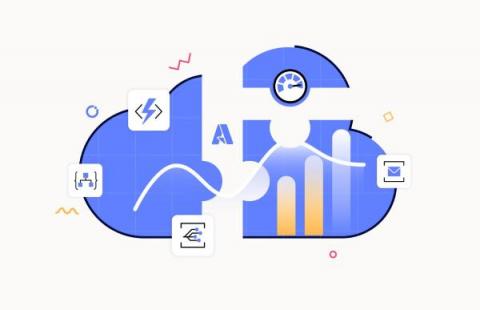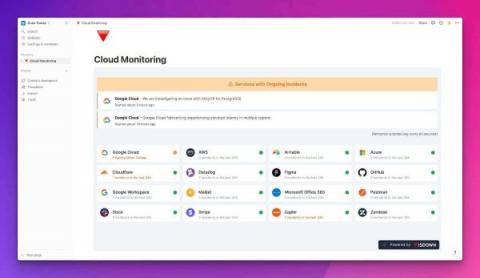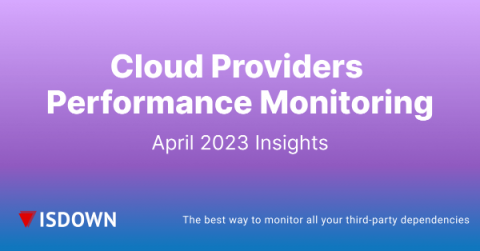Operations | Monitoring | ITSM | DevOps | Cloud
May 2023
The Real Benefits of Cloud Storage for Normal People
Agile Vs. DevOps: 7 Most Common Misconceptions
5 Ways To Find Immediate Cloud Cost Savings Opportunities
Managing the Cyber Threat Landscape in Today's Cloud Environments
What is an Internal Developer Platform (IDP) and Why It Matters
In today's evolving technological landscape, enterprises are under increasing pressure to deliver high-quality software at an accelerated pace. Internal Developer Platforms (IDPs) provide a centralized developer portal that empowers developers with self-service capabilities, standardized development environments, and automation tools to accelerate the software development lifecycle. In this week's blog, we're taking a closer look at internal developer platforms and how implementing IDPs is helping organizations overcome the complexity of modern software development and increase developer efficiency to accelerate the delivery of software products.
Amazon Security Lake & ChaosSearch deliver security analytics with industry-leading cost & unlimited retention
Platform.sh is now using annual carbon intensities from Electricity Maps
One of the value propositions of Platform.sh is to offer greener hosting. By choosing cloud hosting instead of on-premise hosting, you are selecting a greener way to host your applications and websites. In addition, when creating a project, you have the option to choose the greenest region to host it. How?
Infrastructure is Fundamental: Learn Your Hybrid Cloud ABCs
In 21st-century business, computing is what makes daily operations, competitive advantage, and strategic growth possible. The foundation that enables this is a hybrid cloud infrastructure that supports business requirements, delivers a suitable user experience, and stays on budget. Mastering the ABCs of infrastructure performance management (IPM) will put you on the road to long-term success.
The Azure Hybrid tour
What is Azure CAF?
Understanding Azure Storage SAS Tokens
Azure Storage offers a robust set of data storage solutions including Blob Storage, Queue Storage, Table Storage, and Azure Files. A critical component of these services is the Shared Access Signature (SAS), a secure way to provide granular access to Azure Storage services. This article explores the intricacies of Azure Storage SAS Tokens.
AWS ECS Monitoring | Breaking out of the observability vendor lock-in with SigNoz
Azure Data Factory Monitoring and Alerting: The Ultimate Guide
Why Cloud Did Not Kill the Data Center
Migrating to a cloud model would reduce costs and let me focus on consumption pricing; reduce complexity by moving backend software and hardware support to the provider; and increase agility by letting my developers use all those nifty new tools that were emerging daily from cloud providers. The data center was heading the way of the dinosaurs! All was good. Everyone was happy. Well, in theory anyway. Until reality kicked in.
Why Cost Optimization Should Be More Like Pulling Levers, Not Using Scissors
C-Suite's Step-by-Step Guide to Successful AWS Transitioning- Part 2
After in Part 1 we have covered the first critical steps to complete before migrating to Amazon Web Services (AWS)- Cloud Adoption Readiness Assessment (CARA). We will continue Once you’ve assessed your readiness, it’s essential to develop a comprehensive cloud strategy aligning with your business goals and objectives. The strategy should cover key areas – including security, reliability, compliance and operational excellence.
Cloud Reverse Migration: A Comprehensive Guide
The rapid technological advancements in the last decade led to a massive migration of data and applications from on-premise environments to the cloud. While this cloud migration trend dominated the IT world, a recent paradigm shift has emerged that’s moving in the opposite direction – ‘Cloud Reverse Migration’ or ‘Cloud Repatriation’.
How to throw custom exceptions inside Logic Apps: Using default capabilities - Avoiding too many condition actions (Part III)
The True Cost of Moving Fast & Breaking Things - An Engineering Perspective
Revamping Azure Storage: A Look at the 2023 Updates
As we continue to journey through 2023, one of the highlights in the tech world has been the evolution of Azure Storage, Microsoft’s cloud storage solution. Azure Storage, known for its robustness and adaptability, has rolled out several exciting updates this year, each of them designed to enhance user experience, improve security, and provide more flexibility and control over data management.
Crash Course on Building and Monitoring AWS CDK Apps
Virtana Platform Overview
Snowflake Review: Why CloudZero Went With Snowflake
Everything You Need to Know About Google Cloud Logs
As the affordable choice for cloud computing, Google Cloud Platform (GCP) is catching up to its competitors, like AWS and Microsoft Azure. As a business, you need the speed and scalability that the cloud provides, but you want to limit your costs to ensure you hit revenue targets. With GCP, you found a digital services business partner to help you meet your business objectives, a technology that gives you the service availability you want at the speed you need.
CloudWatch Logs to S3: The Easy Way
Four steps to managing your Cloud Logging costs on a budget
Follow these best practices to learn how to get the most out of your Google Cloud and third-party logging infrastructure for the lowest cost.
Tidal CEO Talks Cloud Migration and Optimization with AWS
Tidal CEO, David Colebatch, had the privilege of sitting with Marcus Pozzan, Senior Partner Account Manager for ISVs at AWS Canada for the Canadian Pension Investment Funds Executive Briefing Day on April 18, 2023.
Azure Files Geo-Redundancy:
In the ever-evolving landscape of cloud computing, data redundancy is no longer just an option but a must-have feature for any business looking to fortify its data storage and accessibility. One of the most recent additions to the world of data redundancy is Azure Files’ Geo-Redundancy feature, a 2023 release that’s set to take the world of cloud storage by storm.
Unleash the power of Elastic and Amazon Kinesis Data Firehose to enhance observability and data analytics
As more organizations leverage the Amazon Web Services (AWS) cloud platform and services to drive operational efficiency and bring products to market, managing logs becomes a critical component of maintaining visibility and safeguarding multi-account AWS environments. Traditionally, logs are stored in Amazon Simple Storage Service (Amazon S3) and then shipped to an external monitoring and analysis solution for further processing.
Understand your Azure Active Directory Sign-Ins with KQL
When Azure AD is configured to record Sign-In activity, Kusto KQL can be used to gain valuable insights. This blog walks through common needs and shows how to visualize them in SquaredUp. Ruben Zimmermann is an Infrastructure Architect at a large manufacturing company who likes Azure, KQL, PowerShell and, still, SCOM.
Head-to-Head: Active Directory vs. Azure Active Directory - Which One Wins?
When it comes to identity and access management solutions, two names that often come up are Active Directory (AD) and Azure Active Directory (AAD). While many people are familiar with AD, AAD is still a relatively new concept to some. In this article, we will take a deep dive into both directories and explore their similarities, differences, pros, cons, and everything in between.
What is Cloud Repatriation?
In the modern digital age, the migration of data and applications to the cloud has been a significant trend, prompted by the promise of increased efficiency, scalability, and reduced IT costs. Cloud services such as Microsoft’s Azure Cloud have become increasingly popular, offering a host of services including computing power, storage solutions, and advanced analytics.
Snowflake Vs. AWS Vs. Azure: Which Should You Use?
The Power of Peer-To-Peer Networks and the Rise and Fall of Limewire
Understanding spot pricing trends for a resilient and cost-efficient cloud
EP, 2: Transforming Cloud Infrastructure featuring Lori MacVitte
Maximize cloud efficiency: how to cut costs and keep uptime strong
How Runbook Automation can Simplify CloudOps Use
.Organizations in every industry continue their transition to cloud services, and while this may be a step forward in general, it does bring with it its own unique set of challenges. Cloud use, and in particular CloudOps, relies on a complex and intricate infrastructure which is difficult to manage and maintain, and it's a critical part of keeping a business' networks functioning. This makes finding a way to simplify the use of CloudOps a top priority for many businesses, but does a solution exist?
Microsoft Azure: Unleashing the Potential of Cloud Computing
Microsoft Azure is often hailed for its “limitless potential” and “unlimited possibilities”. But what does that mean in practical terms? How can Azure transform your business operations and why is it worth your attention? In this article, we’ll delve into these questions and illustrate the value of Azure through four key applications that can enhance your business operations and provide tangible benefits.
RDP Shortpath monitoring in Azure
Since Microsoft announced the RDP Shortpath feature was going to be enabled by default on September 6, 2022 for all Azure Virtual Desktop (AVD) customers, monitoring and troubleshooting this feature has become important. RDP Shortpath feature improves the AVD connectivity by establishing a direct UDP protocol between the AVD session hosts and the Remote Desktop Client by reducing the dependency on gateways.
Logic App Best Practices, Tips, and Tricks: #29 How to validate if an Array is empty
Avoid Azure migration cost overruns with Datadog Cloud Cost Management
Migrating your on-prem applications to Azure can help you improve scalability, reliability, and security. It can also help reduce costs and free your engineering teams to focus on innovation and performance optimization. But it can be hard to understand Azure costs as they evolve during your migration and to see how they correlate with your resource utilization once you’re up and running in Azure.
Building and deploying AWS email templates with Azure DevOps
This is the third and final post (for now) in the series about developing email templates with MJML and deploying them to AWS. In the previous post, we developed a Gulp script to automatically build HTML from the MJML file and insert it in a template file for AWS. In this post, we will set up an automated build and deployment of the email template using Azure DevOps. A quick recap.
Understanding Azure Blob Storage Soft Delete: A Comprehensive Guide
Azure Blob Storage is a scalable, cost-effective, and durable cloud storage solution provided by Microsoft Azure. Serving as the backbone for many Azure services, it enables businesses to store a colossal amount of unstructured data ranging from documents, images, backup data, to log files, etc. Azure Blob Storage can handle all your static data that’s stored and read but not changed frequently, making it an indispensable part of any cloud data management strategy.
Why Traditional Cloud Cost Optimization Isn't Enough
Azure App Service Autoscaling: Steps to Configure
Leveraging OpenTelemetry to Fix Flaky Integration Tests
At Lumigo, we heavily depend on a set of tests to deploy code changes fast. For every pull request opened, we bootstrap our whole application backend and run a set of async parallel checks mimicking users’ use cases. We call them integration tests. These integration tests are how we ensure: Recently, we changed our old “traditional log traversing” of integration tests into *amazing* OpenTelemetry traces graphs.
Tidal Accelerator's Update Improves Application Interviews
Logic App Best Practices, Tips, and Tricks: #28 How to check if a string is Null or Empty
The Cloud Cost Optimization 'Easy Button': 3 Keys to Maximizing Your Resource Utilization
Guide to Azure Blob REST API: Upload, Download, Manage, Secure
Azure Blob Storage is a cloud-based storage solution provided by Microsoft as part of its Azure platform. It enables users to store and manage unstructured data such as text, images, videos, and binary data in the cloud. This makes it a highly scalable and cost-effective way to store large amounts of data without having to worry about hardware maintenance or infrastructure management.
Enable monitoring for enterprise-scale Azure environments in minutes with Datadog
As enterprises build and scale business-critical applications on Azure, they need continuous visibility to understand the health and performance of their services. This can be a challenge, especially for enterprises with large-scale deployments that include an ever-increasing number of subscriptions, resources, and teams.
Head in the Clouds (ft. Jo Peterson): Over-tooling Data is Overrated
Mastering Azure Blob Storage Backups: Essential Guide to Data Protection
Have you ever heard of Azure Blob Storage? If you work with data storage, then chances are you’ve at least heard the name. But what exactly is it? In simple terms, Azure Blob Storage is a cloud-based storage solution provided by Microsoft. It’s used to store and manage unstructured data such as text and binary data, including documents, images, videos, and more.
Configuring Azure Logic App Failure Alerts To Stay Ahead
Monitor Azure Pipelines with Datadog CI Visibility
End-to-end visibility into pipelines is crucial for ensuring the health and performance of your CI system, especially at scale. Within extensive CI systems—which operate under the strain of numerous developers simultaneously pushing commits—even the slightest performance regression or uptick in failure rates can compound rapidly and have tremendous repercussions, causing major cost overruns and impeding release velocity across organizations.
Ocean AKS: Serverless Kubernetes for Azure
Azure Service Principals: The Ultimate Guide
Azure Service Principals are a crucial aspect of managing your Azure resources. They provide a secure and efficient way to manage your resources, without the need for human intervention. In this article, we will explore what Azure Service Principals are, how they work, and why they are important. As you may already know, Azure is a cloud computing platform that allows you to host, deploy and manage your applications and services.
GCP Storage Pricing: The No BS Guide To GCP Storage Costs
Why Addressing IT Challenges is Crucial for Business Sustainability and Growth
Unlocking the Power of Premium Block Blob Accounts
Are you tired of sluggish load times when uploading or downloading large files? Do you need a reliable and scalable storage solution for your business or personal use? Look no further than Premium Block Blob Accounts! In this article, we’ll explore what these accounts are and why they’re essential for anyone dealing with large amounts of data.
What is Supercloud? What to consider when monitoring and observing a Supercloud?
In recent months the term “Supercloud” has become increasingly used, particularly in the context of being a successor or qualifier to “multi-cloud”. There isn’t any definitive formal definition, it is essentially yet another buzzword and vendors and analysts are pilling in with their own take and definition to align to their own agendas and product capabilities.
Amazon S3 Cost Optimization: 12+ Ways To Optimize Your S3 Costs
Monitoring Multi-Cloud and Hybrid-Cloud Infrastructures: Challenges and Best Practices
The advent of multi-cloud and hybrid-cloud architectures has created new opportunities for organizations to leverage best-in-class features from various cloud service providers. However, these complex environments present their own unique challenges, especially when it comes to monitoring and managing performance.
Trace your Azure Function application with Elastic Observability
Adoption of Azure Functions in cloud-native applications on Microsoft Azure has been increasing exponentially over the last few years. Serverless functions, such as the Azure Functions, provide a high level of abstraction from the underlying infrastructure and orchestration, given these tasks are managed by the cloud provider. Software development teams can then focus on the implementation of business and application logic.
Kubernetes Design Patterns For Optimal Observability
Technology is a fast-moving commodity. Trends, thoughts, techniques, and tools evolve rapidly in the software technology space. This rapid change is particularly felt in the software the engineers in the cloud-native space make use of to build, deploy, and operate their applications. One particular area where we see rapid evolution in the past few years/months is Observability.
Maximizing Your Cloud Budget: How to Drastically Reduce Your Cloud Costs with Qovery
Unveiling the Locked Secrets: Exploring Azure Storage Data Encryption
Data is the new oil, and it’s crucial to protect it from prying eyes. With the increase in cyber attacks, encryption is more important now than ever before. Azure Storage Data Encryption offers robust security features that help safeguard data stored on Microsoft Azure Platform.
All you need to know about Software Defined Cloud Interconnects
Unlock the Secret of Kubernetes Management: Take This Free Self-Hosted Trial
D2iQ is pleased to offer AWS members a self-hosted free trial of the D2iQ Kubernetes Platform (DKP) on AWS. All that is required is an active AWS account. Once you qualify, you will receive all the directions and credentials you need. Surveys show that the top challenges organizations face in deploying Kubernetes and cloud-native technologies are complexity, security, and a skills gap.
Microsoft Announce Azure Automation Progress & Future Developments
On the 2nd of May 2023, Jaspreet Kaur of the Azure Automation Product Group released this blog, providing an update on updates to Azure Automation in 2022 and what is in the pipeline for 2023. In the blog, Jaspreet detailed the major changes that Microsoft have made to the core of Azure Automation to improve the reliability and scalability of the underlying infrastructure.
Migrating Git Integration for Jira Hosting from Self Hosted to Cloud
Migrating data can be tricky and stressful, even under the best conditions. Jira migrations can be particularly complicated due to the various applications many organizations use in conjunction with it. As you are likely aware of, in an effort to focus on offering a better Cloud service, Jira Server has reached the last stage of its End-of-Life transition, with no further support planned after Feb. 2024.
Is Northern Virginia Really the Least Reliable AWS Region And Why?
AWS users usually assume that Northern Virginia, also referred to as US East (N. Virginia) and us-east-1, is the least reliable in terms of uptime. We analyzed AWS outage history in 2022 across regions to see if N. Virginia, indeed, had the most downtime. Then we reviewed and proved some of the theories as to why N. Virginia has the most outages.
Would You Notice If A Feature Was Costing Your SaaS Company Too Much?
Digital Business Transformation Never Ends-Can Your Infrastructure Keep Up?
Digital transformation—and its intended benefits, including flexibility, scalability, agility, cost control, and more—is enabled by cloud computing. You need all these things because, now more than ever, businesses and markets are highly dynamic. Sometimes it’s an opportunity you want to capitalize on. Other times it’s a threat, such as a disruptive competitor, or a challenge, like new regulatory requirements. Some things you see coming, and others take you by surprise.
What is Cloud Network Monitoring & How it Ensures Sky-High Network Performance
Mastering Azure VMs: Comprehensive Guide to VM Size Selection
Azure virtual machines (VMs) are a powerful tool in the world of cloud computing. They allow you to create and manage virtual machines in the cloud, giving you the freedom and flexibility to run your workloads anywhere, at any time. With Azure VMs, you can easily deploy and scale your applications with minimal fuss. The beauty of Azure VMs is that they provide a secure, highly available infrastructure that can be customized to meet your exact needs.
Navigating the Path to Cloud Migration: Key Challenges and Best Practices
Embarking on a cloud migration journey? Grasp the obstacles and arm yourself with best practices for a smooth transition. Success lies in understanding, planning, and adapting. As we continue to advance further into the 21st century, businesses of all sizes are finding themselves in the midst of a digital revolution.
Mastering Cloud Optimization: Strategies for Enhancing Performance and Reducing Costs
Unlock the full potential of your cloud investment! Discover strategies to enhance performance and reduce costs. In the dynamic world of cloud computing, optimization isn't just about cost reduction. It involves a fine balance between managing costs and maximizing value while ensuring efficient resource allocation.
How We Get Almost Bankrupted Because Of A Documentation Typo
Securing Your Cloud Data with Azure Storage Private Endpoints
Are you storing your data in the cloud? If yes, then you must be aware of the various security challenges that come with it. One of the biggest concerns in cloud computing is securing data from unauthorized access. However, with Azure Storage Private Endpoints, Microsoft has introduced a solution that can help organizations secure their data in the cloud.
Head in the Clouds: Data Value and Versatility with Splunk Cloud Platform
Optimizing Kubernetes Nodes the Right Way
How container networking works at Platform.sh
At Platform.sh, we run containers. Lots and lots of containers. On hundreds of virtual machines rented from various IaaS providers. These containers run your software. They also team up with other containers that run other software that your software depends upon (such as databases or caches). This is naturally an extremely complex system, and today we'll take a look at how we wire (most of) it up.
40 Best Cloud Network Monitoring Tools of 2023 for All Platforms and Giants like AWS, Google, Azure, IBM, and Oracle
Comprehensive Guide to Azure Storage Shared Access Signatures
Azure Storage is a cloud-based storage solution offered by Microsoft as part of the Azure suite of services. It is used for storing data objects such as blobs, files, tables, and queues. Azure Storage offers high scalability and availability with an accessible pay-as-you-go model that makes it an ideal choice for businesses of all sizes. In today’s digital age, data has become the most valuable asset for any business.
Tame Large-Scale Cloud Deployment Costs with FinOps
One of the biggest issues related to large-scale cloud deployments is overspending. It’s no surprise that as organizations scale their cloud-native Kubernetes environments, the associated costs rise along with that growth. However, there is a disconnect between the rising expenses and how well businesses can accurately and effectively monitor and control costs in the cloud, across multiple clouds and in hybrid cloud environments.
Reducing the cost of cloud: Tips for reducing your spend at any cloud provider
Spiraling costs are causing organizations to look for ways to reduce their monthly spend – hidden charges and unexpected bills are surprises that CFOs can no longer afford. With current costs from hyperscaler cloud providers skyrocketing, many are now asking whether going cloud-native is the right move for them. There are, however, a number of tips and tricks that you can action today that will help you reduce your cloud bill at any provider.
Live Event - Cloud Costs Optimization
Achieve deeper infrastructure optimization with Ocean's multi-architecture virtual node groups
N-able Announces Cove Data Protection with Disaster Recovery as a Service, Introducing Microsoft Azure Recovery Option
Comparing Azure, VMware, and Hyper-V
In today’s world of virtualization, IT professionals are often faced with the challenging task of choosing the right platform for their organization’s needs. Azure, VMware, and Hyper-V are three major players in the virtualization market, each with its strengths and weaknesses.
Why should I go for Multi-Cloud?
Why should you migrate to cloud?
The Azure IoT ride with Sander
OneDrive vs iCloud: PC or Mac Cloud Storage?
Cloud Control Full Trailer
Ep. 1: The Art of Managing Strategic Partnerships with Hyperscalers featuring Christine Puccio
6 Best CloudHarmony Alternatives To Consider in 2023
With CloudHarmony retiring on May 15th, 2023, let’s look at CloudHarmony alternatives that can provide you with information on cloud services and help you navigate through comparing one provider to another.
Top 10 Amazon S3 Alternatives in 2024
How to Choose the Best SMS API in 2024
Mastering Azure Storage Account Failover: Switching Without a Glitch
Azure Storage Account Failover is a critical feature offered by Microsoft Azure that provides users with the ability to switch to an alternative instance of their storage account in case of a disaster or an outage. In simple terms, it is the act of transferring control of Azure storage account operations from one region to another, ensuring business continuity and disaster recovery.
Faster Debugging with Collaborative Troubleshooting Tools
As developers we understand the critical role teamwork and collaboration play in solving complex problems. Often, it’s that second set of eyes that uncovers an additional issue or sheds light on the root cause of a stubborn bug. Effective collaboration becomes a critical factor in determining a team’s success or failure, especially when debugging or troubleshooting problematic issues within complex applications.
Reduce cardinality and costs with Grafana Cloud Adaptive Metrics
4 Low-Effort Tactics That Saved CloudZero Over $2M In 2023
Matt Round On How Amazon Reinvented Software Engineering
How to optimize cloud operations in Microsoft Azure
ServiceNow has embraced a three-zero strategy for its digital technology operations: zero unplanned outages, zero physical footprints, and zero user-reported incidents. We adopted a cloud-first policy as part of our zero-physical-footprint strategy. This approach delivers the operational agility we need as a growing company—we can add capacity on demand. With a data-center approach, that would take weeks or months.
What does the future of ecommerce hold? A deep dive with Adobe and Platform.sh
2bcloud Becomes One of the First Solutions Partner Designation in the Microsoft Cloud Partner Program: A Game-Changer for Our Customers
We are thrilled to announce that 2bcloud is one of the first companies worldwide to achieve the Solutions Partner designation in the Microsoft Cloud Solution Partner Program. This is an exciting milestone for our organization, and we are proud to be among the pioneers of this prestigious program. The Solutions Partner designation demonstrates our technical capabilities, experience, and ability to deliver successful customer outcomes aligned to the Microsoft Cloud.
Understanding Excess Cloud Capacity: Amazon EC2 Spot Instances vs. Azure Spot VMs vs. Google Spot VMs
What is WebOps & How it Scales your Websites
If your organization is managing several websites, you’ll understand the challenges involved in keeping everything updated and running smoothly. Deployment, modification, and approval are time-consuming tasks—but the WebOps approach means they don’t have to be. So, what exactly is WebOps, and how does it help you scale your websites? Read on to discover more and learn how Platform.sh can help.
Head in the Clouds: Speed Up Your Innovation With Splunk Cloud Platform
What Makes A Website Good For Both Owner And Visitor?
2bcloud Delivers Cloud Savings to Nucleus Security AWS and Azure Offerings
Debugging tips for common issues with cloud-based applications
Debugging in a cloud environment can be tricky, as it involves multiple layers of abstraction and virtualization. Unlike traditional on-premise environments, cloud environments are highly distributed and dynamic, making it challenging to identify and troubleshoot issues. One of the biggest challenges with debugging cloud applications is the need for more visibility into the underlying infrastructure and the complexity of the application architecture. Fortunately, pinpointing and resolving the cause of the issue is much more manageable with server-side monitoring, detailed error reporting and cloud debugging solutions.
Cloud Transformation Strategy & Solutions
Cloud transformation is real. And it's spectacular. According to global business management and consulting firm McKinsey & Co., cloud transformation is the engine driving $1 trillion in economic activity for Fortune 500 companies alone. Innovations enabled by the cloud touch nearly every aspect of running a successful business, including the development of new products and services, access to new customers and markets, frictionless transactions, streamlined communication and collaboration, and access to talent without concern for traditional geographic barriers.
Internet Trends in 2023: Mary Meeker, Stats, Trends & Predictions
Multi-Cloud, Still an Actual Thing after All These Years
The 2023 edition of VMware’s annual State of Kubernetes report is now out, and it’s got a lot of great information about how organizations are using Kubernetes today, as well as the benefits and challenges that go along with that. In this blog post, I’m focusing on one area: multi-cloud.
Support for Multi-buildpacks released
There are numerous instances where a single buildpack falls short in app building, for instance when working on a NodeJS app with a PHP backend. We are thrilled to announce the global and immediate availability of Multi-Buildpacks for all app sizes, including our Free tier. The Multi-Buildpack feature allows you to: Alongside the introduction of multi-buildpacks, we're expanding support for Add-on buildpacks (such as APT, Static, or the newly introduced FFmpeg buildpacks).
This Month in Datadog: DASH 2023, In-App WAF and User Protection, Cloudcraft for Azure, and more!
Understanding Azure Function App Metrics
2bcloud Delivers Cloud Savings to Nucleus Security
New York, May 4, 2023 – 2bcloud, a leading next-generation multi-cloud managed service provider for tech companies on their cloud journey, today announced that Nucleus Security, a leader in risk-based vulnerability management and process automation, has adopted its cloud services to meet the company’s strong growth while delivering cost savings to its AWS customers.
Cloud Cost Management Demo
Customer story: Nucleus Security
Azure Tenant: Comprehensive Guide to Managing Your Cloud Domain
When it comes to the world of cloud computing, Microsoft Azure is one of the top players in the game. However, managing an Azure environment can be complex and requires a good understanding of its various components. One such component is an Azure tenant. An Azure tenant, also referred to as a directory or a subscription, is essentially a dedicated and isolated instance of the Microsoft Cloud that holds your organization’s data and accounts.
The Spectrum of Cloud Migration Methodologies
Many people think cloud migrations are a binary decision: either lift-and-shift or completely modernize applications. However, the reality is that there is a spectrum of transition types available, each offering different levels of value.
Understanding Azure Subscriptions
Azure Subscriptions are a key component of Microsoft Azure’s cloud platform, as they form the foundation for managing and organizing resources in the Azure environment. In essence, an Azure Subscription is a logical container for resources that are deployed within an Azure account. Each subscription acts as both a billing and access control boundary, ensuring that resources are accurately accounted for and that users have the appropriate permissions to interact with them.
Ubuntu Pro is now part of the Amazon EC2 console
[London, UK, May 2, 2023] – Canonical, a leading open-source provider of cloud computing services, has announced that Ubuntu Pro is now available in a subscription-included model on Amazon Web Services (AWS). Users can now launch Ubuntu Pro on-demand instances and purchase Ubuntu Pro Compute Savings Plans from the Amazon Elastic Compute Cloud (Amazon EC2) console.
Troubleshooting Slow Draining SQS Queues
This post is part of an ongoing series about troubleshooting common issues with microservice-based applications. Read the previous one on intermittent failure. Queues are an essential component of many applications, enabling asynchronous processing of tasks and messages. However, queues can become a bottleneck if they don’t drain fast enough, causing delays, increasing costs, and reducing the overall reliability of the system.
Capture and Enrich ELB Logs in ONE MINUTE
Monitoring Azure Integration Services with Proactive Strategies
How to monitor cloud vendors with Notion and IsDown
In our modern business environment, it's important to stay updated on the status of the cloud services we use daily. Many companies depend on multiple cloud platforms for different aspects of their work, and having a single place to monitor them all can make a big difference. Notion, a popular all-in-one workspace tool, can help improve team communication, while IsDown makes it easy to track cloud vendors' status pages.
Cloud Provider Performance Monitoring: April 2023 Insights
Explore our insightful April 2023 report on the performance of top cloud providers. We've carefully assessed the health of these leading services by monitoring outages and issues throughout the month. Using data from their official status pages, we've normalized the information to create a clear and concise overview of their reliability. Find out how your favorite cloud provider stacks up in this essential report.
Hyper-V Best Practices
Virtualization has become an essential component of modern IT infrastructure, enabling organizations to optimize their resources, improve efficiency, and reduce costs. Microsoft Hyper-V, a popular virtualization technology, allows for the creation and management of virtual machines (VMs) on a physical server. It enables multiple operating systems to run simultaneously on the same hardware, providing both flexibility and scalability.















